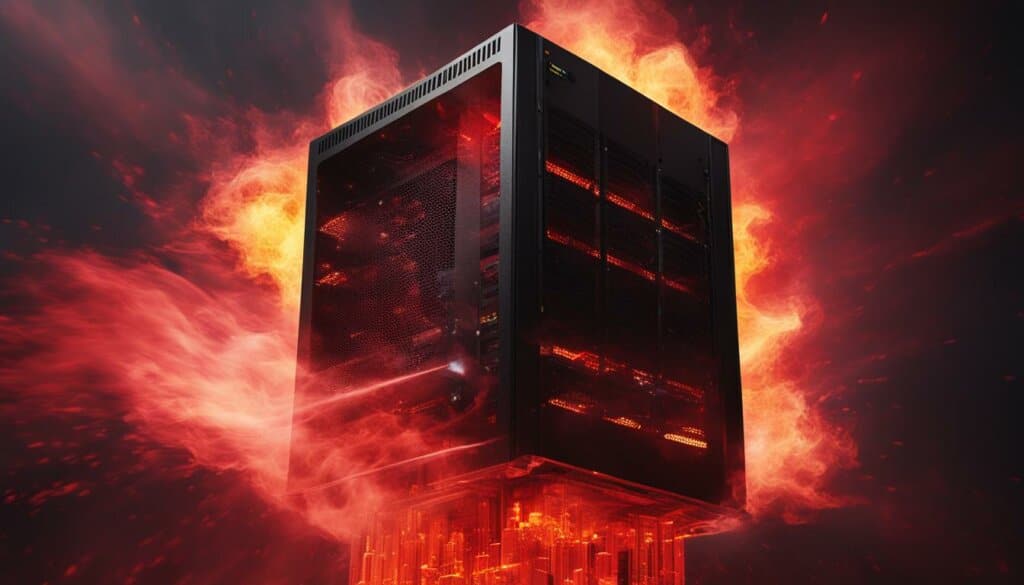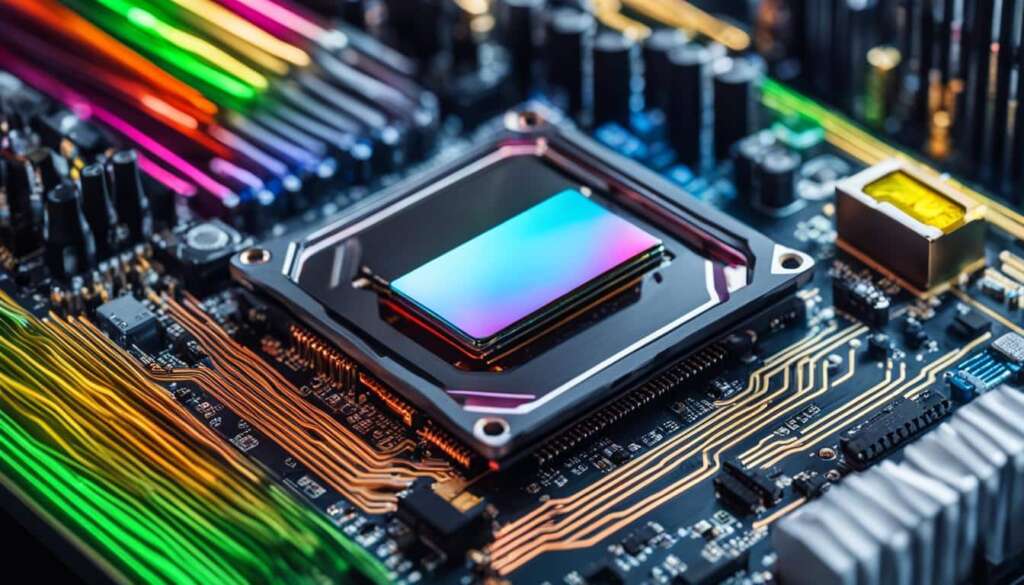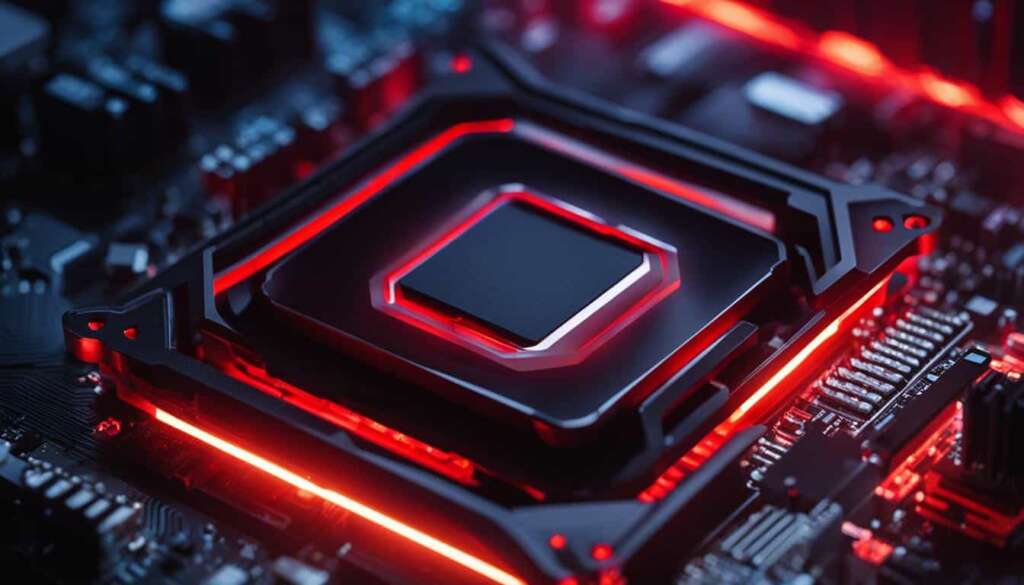Table of Contents
CPU utilization and CPU load are crucial factors in understanding the performance of your system. In this article, we will delve into the explanations and fixes for high CPU usage, providing you with valuable insights to optimize your system’s performance.
When referring to CPU utilization, we are concerned with the percentage of work the CPU is handling to manage tasks. On the other hand, CPU load is a measurement of the number of processes being executed or waiting to be executed. High load averages indicate an overloaded CPU with too many processes.
To effectively monitor CPU load, it is essential to measure various metrics, including idle time, user time, system time, I/O wait time, and steal time. These metrics provide valuable information about the overall CPU load and can help you identify potential issues.
High CPU load can have a significant impact on system performance, potentially causing freezing or slowdowns. It is important to understand the effects of high CPU load and take necessary steps to mitigate them.
Key Takeaways:
- CPU utilization refers to the percentage of work the CPU is handling to manage tasks.
- CPU load is a measurement of the number of processes being executed or waiting to be executed.
- Monitoring CPU load involves measuring idle time, user time, system time, I/O wait time, and steal time.
- High CPU load can negatively impact system performance, causing freezing or slowdowns.
- Identifying and troubleshooting high CPU load requires using commands like top and ps to monitor system performance and identify processes causing the high load.
CPU Utilization vs. CPU Load
In the world of computer processing, understanding the concepts of CPU utilization and CPU load is crucial for optimizing performance. CPU utilization refers to the percentage of work the CPU is handling, while CPU load measures the number of processes being executed or waiting to be executed. Let’s delve deeper into the differences between these two metrics and explore their significance in system performance.
In simple terms, CPU utilization represents how busy the CPU is at a given moment. It indicates the amount of work the CPU is handling, with higher percentages indicating more workload. On the other hand, CPU load refers to the number of processes that are actively using or waiting to use the CPU.
“The CPU is like a conductor, juggling multiple tasks simultaneously.”
Load averages provide a comprehensive view of CPU load by displaying the average number of threads actively requesting to use the CPU over specific time intervals. As load averages increase, it indicates an overloaded CPU with too many processes competing for resources.
It’s important to note that load averages are influenced by the number of CPU cores installed on the system. The load averages scale in proportion to the number of CPU cores. For example, a CPU with 4 cores will have an accumulated load average of 4. If the load exceeds the number of cores installed, processes will begin to queue up, leading to potential performance issues and delays.
To illustrate this further, let’s consider a scenario where a system has a four-core CPU. If the accumulated load average exceeds 4, such as 5 or 6, it indicates that there are more processes waiting to use the CPU than it can handle efficiently. In such cases, the CPU becomes overwhelmed, and performance degradation may occur.
Understanding the relationship between CPU utilization, CPU load, and the number of CPU cores is crucial for scaling system resources effectively. By evaluating load averages and ensuring they fall within the capabilities of the CPU, system administrators can avoid an overloaded CPU and maintain optimal performance.
| CPU Cores | Load Average |
|---|---|
| 2 | 3.5 |
| 4 | 7 |
| 8 | 14 |
The table above illustrates the relationship between the number of CPU cores and the corresponding load averages. As evident, the load average scales with the number of CPU cores, providing a clear perspective on system utilization.
Optimizing CPU utilization and managing CPU load are essential for maintaining the efficiency and responsiveness of computer systems. By understanding these metrics and their scaling with CPU cores, system administrators can make informed decisions when it comes to resource allocation and performance optimization.
Stay tuned as we explore the methods for monitoring CPU load in the next section as we continue our journey towards understanding and troubleshooting high CPU load.
Monitoring CPU Load
Monitoring CPU load is essential for optimizing system performance and ensuring efficient resource allocation. By measuring various metrics, such as idle time, user time, system time, I/O wait time, and steal time, you can gain valuable insights into the CPU’s workload and identify potential bottlenecks.
“Efficiently monitoring CPU load allows for effective troubleshooting and proactive management of system resources.”
Idle Time
Idle time refers to the period when the CPU is not executing any tasks. It is inversely related to CPU load, meaning that when idle time increases, CPU load decreases. Monitoring idle time can help assess the level of CPU utilization and identify periods of low workload.
User Time and System Time
User time and system time directly reflect the CPU’s load. User time represents the percentage of CPU time spent executing user processes, while system time represents the percentage of CPU time spent executing system-level processes. Higher values of user time and system time indicate a higher load on the CPU.
I/O Wait Time
I/O wait time occurs when the CPU is idle and waiting for input/output operations to complete. This can significantly increase CPU load, as the CPU remains idle during this waiting period. Monitoring I/O wait time can help identify processes or operations that are causing delays and impacting overall system performance.
Steal Time
Steal time refers to the percentage of time a virtual CPU waits for a physical CPU to become available when running in a virtualized environment. In this scenario, when the hypervisor is servicing another virtual CPU, the waiting virtual CPU experiences steal time. Monitoring steal time is crucial for assessing the impact of resource allocation and prioritize critical processes to optimize overall system performance.
By keeping a close eye on these metrics, system administrators can identify potential performance issues, detect CPU bottlenecks, and implement appropriate optimizations. Let’s take a look at an example of CPU load monitoring in action:
| Metric | Value |
|---|---|
| Idle Time | 40% |
| User Time | 50% |
| System Time | 20% |
| I/O Wait Time | 5% |
| Steal Time | 2% |
In this example, the CPU is currently experiencing a moderate load, with relatively high user and system time. However, the idle time is still significant, indicating room for additional workload without overloading the CPU. Monitoring and analyzing these metrics can help system administrators make informed decisions regarding resource allocation, process prioritization, and overall system optimization.
Effects of High CPU Load
A high CPU load can have mild to severe impacts on system performance. Extended periods of running the CPU at 100% capacity can lead to system freezes or unresponsiveness, resulting in unscheduled restarts. Multiple CPU-intensive programs and applications may take longer than expected to start or may not be able to open simultaneously.
The applications or the entire system may become extremely slow and start to lag. Running a system at full capacity can also lead to overheating, which negatively impacts performance. Adjusting the speed of the CPU fan in the BIOS setup can help improve a system’s processing power.

| Impact | Description |
|---|---|
| System Freezes | Long periods of high CPU load can cause the entire system to freeze or become unresponsive, necessitating unscheduled restarts. |
| Slow Speed | With an overloaded CPU, multiple programs and applications may take longer than usual to start or may not open at all. |
| Performance Lag | The entire system or specific applications may experience significant slowdowns and lag due to high CPU load, affecting overall performance. |
| Overheating | Running the CPU at full capacity generates excessive heat, potentially leading to overheating and subsequent performance degradation. |
Identifying and Troubleshooting High CPU Load
To effectively manage high CPU load and optimize system performance, it is crucial to identify the processes causing the load and take appropriate action. This section explores two essential commands – top and ps – that aid in identifying and troubleshooting high CPU load.
Using the top Command
The top command provides real-time statistics of a running system and offers valuable insights into CPU load averages and various system metrics. By using this command, you can monitor the processes consuming significant CPU resources, helping you pinpoint the exact cause of high CPU load.
Note: The top command is often utilized by system administrators and advanced users to analyze CPU utilization and make informed decisions based on the system’s resource usage.
Understanding the ps Command
The ps command enables you to identify running processes and their resource usage. By analyzing this information, you can determine which processes are contributing to the high CPU load. This command provides valuable insights into the state of processes, their IDs, memory usage, and CPU utilization.
Note: When using the ps command, it is essential to consider the options and parameters available to tailor the output to your specific requirements.
Troubleshooting High CPU Load
Once you have identified the processes causing the high CPU load, it is crucial to take appropriate actions to alleviate the issue. Here are some troubleshooting steps you can take:
- Killing or restarting processes: Terminate or restart processes that are consuming excessive CPU resources, allowing the CPU to allocate its power to other critical tasks. This can be done using termination signals or process IDs.
- Updating system apps and drivers: Ensure that your system’s applications and drivers are up to date. Outdated software can sometimes lead to high CPU load. Updating them can help optimize performance and resolve any compatibility issues.
- Reinstalling or downgrading apps: If a specific application is consistently causing high CPU load, consider reinstalling or downgrading it to a previous version. This can eliminate any bugs or performance issues introduced in the current version.
- Rebooting the system: In some cases, rebooting the system can effectively resolve high CPU load issues. Rebooting allows the system to start fresh and clear any underlying processes or issues causing the high load. However, this should be considered as a last resort option.
| Troubleshooting Actions | Benefits |
|---|---|
| Killing or restarting processes | Release CPU resources for other tasks |
| Updating system apps and drivers | Optimize performance and resolve compatibility issues |
| Reinstalling or downgrading apps | Eliminate bugs or performance issues introduced in current versions |
| Rebooting the system | Reset processes and clear underlying issues causing high load |
By employing the top and ps commands and taking the necessary troubleshooting actions, you can effectively identify and address the root causes of high CPU load, optimizing system performance and ensuring smooth operations.
Common Fixes for High CPU Load
To reduce high CPU load, there are several common fixes that can be applied. Killing or restarting processes can help address issues where a single process is causing the high CPU load. Updating system apps and drivers is important to ensure optimal performance and avoid high CPU load caused by outdated software. Sometimes, reinstalling an app that is causing high CPU load can resolve the issue, or downgrading to a lower or previous version of the app may improve performance. As a last resort, rebooting the system may solve the problem if other fixes are not effective. However, rebooting may not be possible in certain situations, such as a server that cannot be shut down.
Troubleshooting Steps:
- Kill or restart processes that are causing high CPU load.
- Update system apps and drivers to ensure optimal performance.
- Reinstall or downgrade problematic apps.
- If all else fails, reboot the system.
“Killing or restarting processes can address high CPU load caused by a single misbehaving process. Updating apps and drivers helps keep the system running smoothly, minimizing the risk of high CPU load due to outdated software. Reinstalling or downgrading apps can resolve issues with specific applications that are causing excessive CPU usage. And if none of these fixes prove effective, rebooting the system can provide a fresh start and potentially resolve lingering CPU load problems.”
Conclusion
High CPU usage can have a significant impact on system performance, causing issues such as freezing and slow speeds. However, there are effective ways to identify and troubleshoot the underlying problems causing high CPU load.
Monitoring CPU load and utilizing commands like top and ps can help identify the specific processes that are causing the high CPU usage. By gaining insights into these processes, you can take appropriate actions to address the issue.
Common fixes for high CPU load include killing or restarting problematic processes, updating apps and drivers to ensure optimal performance, and even reinstalling or downgrading apps if necessary. In some cases, rebooting the system can also help resolve the high CPU usage problem.
To prevent issues related to high CPU usage, it is crucial to regularly monitor CPU load and take appropriate actions. By optimizing system performance and addressing high CPU load, you can ensure smooth and efficient operation of your computer or server.
FAQ
What is CPU utilization?
CPU utilization refers to the percentage of work the CPU is handling to manage tasks.
What is CPU load?
CPU load is a measurement of the number of processes being executed or waiting to be executed by the CPU.
How do load averages indicate an overloaded CPU?
High load averages indicate an overloaded CPU with too many processes.
What metrics are involved in monitoring CPU load?
Monitoring CPU load involves measuring idle time, user time, system time, I/O wait time, and steal time.
What are the effects of high CPU load on system performance?
High CPU load can negatively impact system performance, causing freezing or slowdown.
How can high CPU load be identified and troubleshooted?
High CPU load can be identified and troubleshooted using commands like top and ps to monitor system performance and identify processes causing the high CPU load.
What are some common fixes for high CPU load?
Common fixes for high CPU load include killing or restarting processes, updating drivers and apps, reinstalling or downgrading apps, and rebooting the system.







